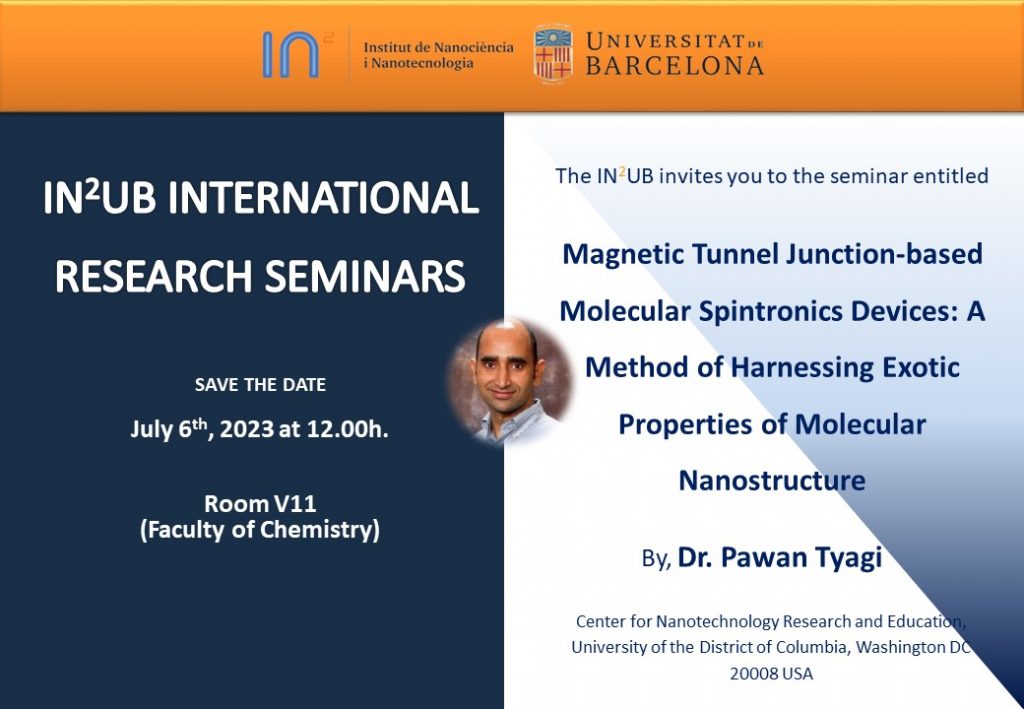IN²UB INTERNATIONAL RESEARCH SEMINARS
Magnetic Tunnel Junction-based Molecular Spintronics Devices: A Method of Harnessing Exotic Properties of Molecular Nanostructure
By, Dr. Pawan Tyagi, Center for Nanotechnology Research and Education, University of the District of Columbia, Washington DC 20008 USA
Date and Venue: July 6th, 2023 at 12.00h – Room V11 (Faculty of Chemistry)
(Chaired by Dr. E. Carolina Sañudo, IN²UB and Faculty of Chemistry)
Abstract: Magnetic Tunnel Junction-based Molecular Spintronics Devices: A Method of Harnessing Exotic Properties of Molecular Nanostructure
Pawan Tyagi*, Marzieh Savadkoohi, Eva Mutunga, Pius Suh, and Andrew Grizzle
Center for Nanotechnology Research and Education,
University of the District of Columbia, Washington DC 20008 USA
Molecule-based devices may govern the advancement of logic and memory devices for next-generation computers and may be suitable for quantum computation. Molecules are unparalleled nanostructures to serve as device elements because chemists can mass-produce a variety of molecules with unique optical, magnetic, and transport characteristics. However, the biggest challenge is to connect two or three metal electrodes to the Molecule (s) and develop a robust and versatile device fabrication technology that can be adopted for commercial-scale mass production. Utilizing tunnel junction as a testbed for making molecular devices solve many critical problems [1]. We focused on producing magnetic tunnel junction-based molecular devices (MTJMSD). This talk will show that an MTJMSD evolves when molecules are bridged along the exposed side edges of a tunnel junction. With the MTJMSD approach, many unprecedented advantages become available to devise researchers. MTJMSD enables the connection between ferromagnetic electrodes and a variety of molecules with the spin state. For the first time, the MTJMSD approach enabled magnetic measurements and conventional transport studies[1]. Magnetic studies showed that molecules could transform the magnetic[2] and transport properties of the MTJs[3] at room temperature. Molecules’ strong impact on ferromagnetic electrodes produced several orders resistance changes at room temperature. An MTJMSD approach is a high yield method and can be mass-produced with the conventional microfabrication tools present in typical labs. Our MTJMSD approach also allows numerous control experiments to provide a deep understanding of device mechanisms. This talk will demonstrate two types of control experiments to prove that we successfully made a molecular device. The first control experiment is the reversible impact of making and braking molecular channels on the overall charge transport. We also performed ferromagnetic resonance before and after damaging the tunnel barrier and damaging the molecular channels by using the plasma. In addition, this talk will discuss how the MTJMSD approach is also suitable for making light sensors, biochemical sensors, as molecules are present in the open region.
REFERENCES
1. P. Tyagi, «Multilayer edge molecular electronics devices: a review,» J. Mater. Chem., vol. 21, pp. 4733-4742, 2011.
2. P. Tyagi, C. Baker, and C. D’Angelo, «Paramagnetic Molecule Induced Strong Antiferromagnetic Exchange Coupling on a Magnetic Tunnel Junction Based Molecular Spintronics Device,» Nanotechnology, vol. 26, p. 305602, 2015.
3. P. Tyagi and E. Friebe, «Large Resistance Change on Magnetic Tunnel Junction based Molecular Spintronics Devices,» J. Mag. Mag. Mat., vol. 453, pp. 186-192, 2018.
Biography
Prof. Pawan Tyagi is currently leading NSF-CREST Center for Nanoscale Research and Education (CNRE). Under his leadership, CNRE is supporting UDC’s new PhD program, multidisciplinary faculty, and nanotechnology skill building from high school to postdoctoral level. He is also the director of the DOE-NNSA Sponsored Consortium of Additive Manufacturing Post Processing Partnerships (AMP3). Prof Tyagi directs the AMP3 consortium comprising four HBCUs and three DOE industries to develop a diverse workforce via industry-oriented, cutting-edge research. Prof. Pawan Tyagi is actively researching to harness molecular nanostructure strength as futuristic computer device components, biochemical sensors, and renewable energy harvesting metamaterials. Prof. Tyagi has also contributed to surface improvement technologies for complex shaped metal 3D printed parts. He is also the inventor of Student Presentation-based Effective Teaching (SPET). Driven by his passion for improving diverse students’ intellectual potential, he pioneered the development of Positive Intelligence training in engineering education at UDC. He conducted effective teaching workshops for >300 internal STEM faculty. Prof. Tyagi has 24 years of materials science experience, from his BS and MS in metallurgical and materials engineering at the Indian Institute of Technology (IIT), and two years of industrial experience in metal manufacturing. His doctoral study was in molecular spintronics at the University of Kentucky. Prof. Tyagi further expanded his skills with postdoctoral research in nano-microscale biomedical sensors and devices at Johns Hopkins University. He received the university-wide 2022 Excellence in Teaching Award from the UDC president and the 2020 Innovator of the year award at the BEYA STEM conference. He has more than 65 peer-reviewed publications and three US patents.
With the support of PhD Program on Nanoscience

